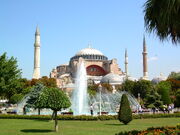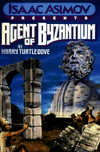GusF (Message Wall | contribs) |
No edit summary |
||
| Line 1: | Line 1: | ||
'''[[File:Hagia_Sofia.jpg|thumb]]Hagia Sophia''' is a former [[Eastern Orthodox]] patriarchal basilica, later a mosque, and now a museum in [[Istanbul]], [[Turkey]]. From the date of its dedication in 360 until 1453, it served as the cathedral of [[Constantinople]], except between 1204 and 1261, when it was converted to a [[Catholic]] cathedral under the Latin Patriarch of Constantinople of the Western Crusader established Latin Empire. The building was a mosque from 1453 until 1931, when it was secularized. It was opened as a museum in 1935. |
'''[[File:Hagia_Sofia.jpg|thumb]]Hagia Sophia''' is a former [[Eastern Orthodox]] patriarchal basilica, later a mosque, and now a museum in [[Istanbul]], [[Turkey]]. From the date of its dedication in 360 until 1453, it served as the cathedral of [[Constantinople]], except between 1204 and 1261, when it was converted to a [[Catholic]] cathedral under the Latin Patriarch of Constantinople of the Western Crusader established Latin Empire. The building was a mosque from 1453 until 1931, when it was secularized. It was opened as a museum in 1935. |
||
| + | |||
| + | ==Hagia Sophia in ''[[Agent of Byzantium]]''== |
||
| + | [[Basil Argyros (Strange Eruptions)|Basil Argyros]] and his wife [[Helen Moskha|Helen]] went to pray at the '''Hagia Sophia''' during their life together.<ref>''[[Agent of Byzantium]]'', 2018 edition, pgs. 49-51.</ref> |
||
| + | |||
| + | In 1317, [[Patriarch of Constantinople (Agent of Byzantium)|Patriarch]] [[Eutropios]] read his anathema against [[Iconoclasm (Agent of Byzantium)|iconoclasm]] at the great church.<ref>Ibid., pgs. 235-236.</ref> |
||
==Hagia Sophia in "[[The Emperor's Return]]"== |
==Hagia Sophia in "[[The Emperor's Return]]"== |
||
| Line 10: | Line 15: | ||
With the city back in Christian hands, Constantine XI awoke from his slumber shortly after the soldiers entered. Once he announced his intention to assert his rule again, Greek sergeant [[Yannis Pappas]] gunned the Emperor down and left his body in the Hagia Sophia. |
With the city back in Christian hands, Constantine XI awoke from his slumber shortly after the soldiers entered. Once he announced his intention to assert his rule again, Greek sergeant [[Yannis Pappas]] gunned the Emperor down and left his body in the Hagia Sophia. |
||
| + | ==References== |
||
| + | {{Reflist}} |
||
| + | {{Agent of Byzantium}} |
||
{{The Emperor's Return}} |
{{The Emperor's Return}} |
||
[[Category:Places of Worship]] |
[[Category:Places of Worship]] |
||
| + | [[Category:Agent of Byzantium]] |
||
[[Category:The Emperor's Return]] |
[[Category:The Emperor's Return]] |
||
Revision as of 10:51, 4 September 2020

Hagia Sophia is a former Eastern Orthodox patriarchal basilica, later a mosque, and now a museum in Istanbul, Turkey. From the date of its dedication in 360 until 1453, it served as the cathedral of Constantinople, except between 1204 and 1261, when it was converted to a Catholic cathedral under the Latin Patriarch of Constantinople of the Western Crusader established Latin Empire. The building was a mosque from 1453 until 1931, when it was secularized. It was opened as a museum in 1935.
Hagia Sophia in Agent of Byzantium
Basil Argyros and his wife Helen went to pray at the Hagia Sophia during their life together.[1]
In 1317, Patriarch Eutropios read his anathema against iconoclasm at the great church.[2]
Hagia Sophia in "The Emperor's Return"
On 29 May 1453, Emperor Constantine XI Palaiologos entered the Hagia Sophia as the Ottoman Empire overran Constantinople. After informing a priest that he would not flee, Constantine asked for a miracle: for God to let him see the city in Christian hands again.
With that, a mantle of flame bathed the emperor, and he sank into the marble floor before the eyes of the startled priest. Constantinople fell shortly after, and Constantine's body was never found.
On 7 June 2003, Istanbul was overrun by Greece and the Soviet Union during their war with Turkey. Four Greek soldiers entered the Hagia Sophia. Early in the fighting, Turkish snipers had used a minaret as a roost, until a Greek jet destroyed it.
With the city back in Christian hands, Constantine XI awoke from his slumber shortly after the soldiers entered. Once he announced his intention to assert his rule again, Greek sergeant Yannis Pappas gunned the Emperor down and left his body in the Hagia Sophia.
References
- ↑ Agent of Byzantium, 2018 edition, pgs. 49-51.
- ↑ Ibid., pgs. 235-236.
| |||||||||||||
| |||||||||||
